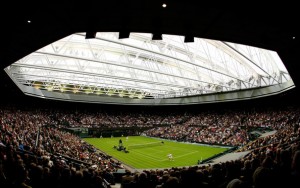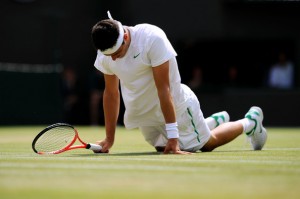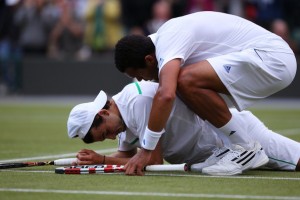At an unguarded moment some days prior to The Championships just gone, the idea occurred to me that the world’s most prestigious tennis tournament is not as good as it should be. I utter this sotto voce, the way all blasphemies are born (rehearsed coyly, but gaining boldness when neither divine nor state retribution eventuates).  And I’m not concerned about the immaculate venue, or the daft coverage, or the line judge’s hopelessly bland attire. I speak only of the tennis, which might well be as good as it can be, but is nothing like as good as it should be.
And I’m not concerned about the immaculate venue, or the daft coverage, or the line judge’s hopelessly bland attire. I speak only of the tennis, which might well be as good as it can be, but is nothing like as good as it should be.
Ask yourself: how much better would the top players perform if Wimbledon arrived at the end of a grass season comparable with the Roland Garros lead-up, and if they hadn’t transitioned from clay scant weeks earlier. If we accept that even today’s stately and stable grass requires specialised skills in order to flourish, then we must surely concede that a longer lead-in would see those skills honed more finely still. A week or two is not enough.
Unlike clay, which rewards that special array of strengths happily concentrated in Rafael Nadal, grass court mastery in this post-serve-volley era largely boils down to limiting its detriment on one’s normal, which is to say hardcourt, game. Following that too-long clay season, there is a mad scramble to limit how thoroughly the new surface makes seasoned pros look like hackers. We might say that grass rewards variety, but it’s equally if not more accurate to say that it really penalises players who cope poorly with variety, which is to say, most of them. I doubt whether Robin Soderling would have had anything like as much trouble with Bernard Tomic on an indoor hardcourt, crook gut or not. But Soderling fares ill when multiple variables are involved, and Tomic on grass was an entire asylum of them. For Exhibits B through D, see Roger Federer, Alexandr Dolgopolov, and the wind. More play on grass might conceivably help Soderling, but it would certainly help other players even more. What might the rankings look like if the grass and clay seasons were switched. Can you picture Philip Petzschner in the top ten?
That said, it would probably help the top players the most of all, notwithstanding that they’re on top precisely because they demonstrate year-round mastery at limiting the extent to which vagaries of surface, mood, vibe, form and location impact their games. It is perhaps a churlish point to make, given that Wimbledon has given us three all-time classic finals in the last five years. Federer on grass between 2003 and 2008 proved almost unbeatable, and what a terrible and wondrous idea it is to imagine how much better he might have been had he actually trained on it for more than a few weeks each year.
Bernard Tomic
The point is occasionally made that the Slams are so interesting due to the length of the events themselves, for the way a narrative arc can develop over two weeks in a way that it can’t over one. It seems a fair enough point, until we try to recall anything that happened in the first week of just about any major in the last ten years. There was plenty that seemed momentous at the time – random recollection: Richard Fromberg’s improbable run to the Australian Open fourth round in 1998 –  and these tend to provoke a rapidly self-consuming media frenzy. Unless you’re going 70-68 in the fifth, the improbable run must extend into the second week if it is to outpace history’s eroding touch. Even then, a mighty quarterfinal might be gone before the decade is out. What do we retain from the 2006 Australian Open? Remember Nicolas Kiefer’s heroic journey to the final four? No, me neither. I recall Marcos Baghdatis tearing the draw apart, and Federer blubbing on Rod Laver’s shoulder at the trophy presentation.
and these tend to provoke a rapidly self-consuming media frenzy. Unless you’re going 70-68 in the fifth, the improbable run must extend into the second week if it is to outpace history’s eroding touch. Even then, a mighty quarterfinal might be gone before the decade is out. What do we retain from the 2006 Australian Open? Remember Nicolas Kiefer’s heroic journey to the final four? No, me neither. I recall Marcos Baghdatis tearing the draw apart, and Federer blubbing on Rod Laver’s shoulder at the trophy presentation.
That bundle of multiple variables known as Bernard Tomic reached the quarterfinals at Wimbledon this year, and pushed the eventual winner and new world No.1. He was the youngest player to progress so far since Boris Becker in 1986. But if he never goes on to greater accomplishments, almost no one will remember. We only remember that particular accolade of Becker’s because he went on to defend the title, and then went on to be Boris Becker. Unless Tomic’s run proves to be a breakout, it will count for little, a mere footnote, one of the dully informative ones you ignore. If Tomic goes on with it, and eventually reaches the heights of the men’s game, then this may be remembered as a key moment. Now, as then, time will tell.
Jo-Wilfried Tsonga
Jo-Wilfried Tsonga’s first and most definitive breakout performance came at the 2008 Australian Open. His career since has seen him adhere rigorously to a timetable alternating injury with  further outbreaks, and one can feel safe in assuming it will go this way until he retires. Wimbledon 2011 witnessed the latest of his peaks.
further outbreaks, and one can feel safe in assuming it will go this way until he retires. Wimbledon 2011 witnessed the latest of his peaks.
If pressed, Tsonga would doubtless choose as his highlight those three flawless sets he inflicted on Roger Federer. But for me, and apparently for others as well, the standout match was that second round tussle with Grigor Dimitrov, a fabulously skilled and sporting encounter. Had the Frenchman’s form been less transcendent, there is every chance Dimitrov would have won it. Wimbledon 2011 might have been his moment, too. But it was not to be. History was all luck once, and it still is.
